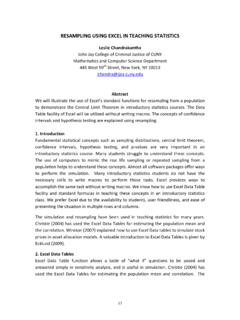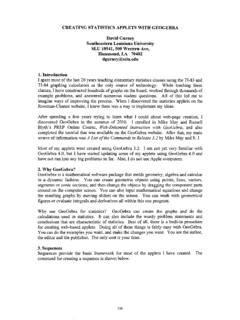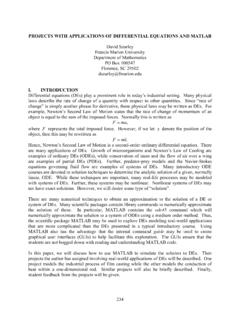Transcription of USING EXCEL SOLVER IN OPTIMIZATION PROBLEMS
1 USING EXCEL SOLVER IN OPTIMIZATION PROBLEMS Leslie Chandrakantha John Jay College of Criminal Justice of CUNY Mathematics and Computer Science Department 445 West 59th Street, New York, NY 10019 Abstract We illustrate the use of spreadsheet modeling and EXCEL SOLVER in solving linear and nonlinear programming PROBLEMS in an introductory operations research course. This is especially useful for interdisciplinary courses involving OPTIMIZATION PROBLEMS . We work through examples from different areas such as manufacturing, transportation, financial planning, and scheduling to demonstrate the use of SOLVER . Introduction OPTIMIZATION PROBLEMS are real world PROBLEMS we encounter in many areas such as mathematics, engineering, science, business and economics. In these PROBLEMS , we find the optimal, or most efficient, way of USING limited resources to achieve the objective of the situation. This may be maximizing the profit, minimizing the cost, minimizing the total distance travelled or minimizing the total time to complete a project.
2 For the given problem , we formulate a mathematical description called a mathematical model to represent the situation. The model consists of following components: Decision variables: The decisions of the problem are represented USING symbols such as X1, X2, X3,..Xn. These variables represent unknown quantities (number of items to produce, amounts of money to invest in and so on). Objective function: The objective of the problem is expressed as a mathematical expression in decision variables. The objective may be maximizing the profit, minimizing the cost, distance, time, etc., Constraints: The limitations or requirements of the problem are expressed as inequalities or equations in decision variables. If the model consists of a linear objective function and linear constraints in decision variables, it is called a linear programming model. A nonlinear programming model consists of a nonlinear objective function and nonlinear constraints.
3 Linear programming is a technique used to solve models with linear objective function and linear constraints. The Simplex Algorithm developed by Dantzig (1963) is used to solve linear programming PROBLEMS . This technique can be used to solve PROBLEMS in two or higher dimensions. 42In this paper we show how to use spreadsheet modeling and EXCEL SOLVER for solving linear and nonlinear programming PROBLEMS . Spreadsheet Modeling and EXCEL SOLVER A mathematical model implemented in a spreadsheet is called a spreadsheet model. Major spreadsheet packages come with a built-in OPTIMIZATION tool called SOLVER . Now we demonstrate how to use EXCEL spreadsheet modeling and SOLVER to find the optimal solution of OPTIMIZATION PROBLEMS . If the model has two variables, the graphical method can be used to solve the model. Very few real world PROBLEMS involve only two variables. For PROBLEMS with more than two variables, we need to use complex techniques and tedious calculations to find the optimal solution.
4 The spreadsheet and SOLVER approach makes solving OPTIMIZATION PROBLEMS a fairly simple task and it is more useful for students who do not have strong mathematics background. The first step is to organize the spreadsheet to represent the model. We use separate cells to represent decision variables, create a formula in a cell to represent the objective function and create a formula in a cell for each constraint left hand side. Once the model is implemented in a spreadsheet, next step is to use the SOLVER to find the solution. In the SOLVER , we need to identify the locations (cells) of objective function, decision variables, nature of the objective function (maximize/minimize) and constraints. Example One (Linear model): Investment problem Our first example illustrates how to allocate money to different bonds to maximize the total return (Ragsdale 2011, p. 121). A trust office at the Blacksburg National Bank needs to determine how to invest $100,000 in following collection of bonds to maximize the annual return.
5 Bond Annual Return Maturity Risk Tax-Free A Long High Yes B Short Low Yes C Long Low No D Long High Yes E Short High No The officer wants to invest at least 50% of the money in short term issues and no more than 50% in high-risk issues. At least 30% of the funds should go in tax-free investments, and at least 40% of the total return should be tax free. Creating the Linear Programming model to represent the problem : Decision variables are the amounts of money should be invested in each bond. X1 = Amount of money to invest in Bond A 43X2 = Amount of money to invest in Bond B X3 = Amount of money to invest in Bond C X4 = Amount of money to invest in Bond D X5 = Amount of money to invest in Bond E Objective Function: Objective is to maximize the total annual return. Maximize f(X1, X2, X3, X4, X5) = + 8%X2 + 9%X3 + 9%X4 + 9%X5 Constraints: Total investment: X1 + X2 + X3 + X4 + X5 = 100,000. At least 50% of the money goes to short term issues: X2 + X5 >= 50,000. No more than 50% of the money should go to high risk issues: X1 + X4 + X5 <= 50,000.
6 At least 30% of the money should go to tax free investments: X1 + X2 + X4 >= 30,000. At least 40% of the total annual return should be tax free: + 8%X2 + 9%X4 >= 40%( + 8%X2 + 9%X3 + 9%X4 + 9%X5) Nonnegativity constraints (all the variables should be nonnegative): X1, X2, X3, X4, X5 >= 0. Complete linear programming model: Max: .095X1 + .08X2 + .09X3 +.09X4 + .09X5 Subject to: X1 + X2 + X3 + X4 + X5 = 100,000. X2 + X5 >= 50,000. X1 + X4 + X5 <= 50,000. X1 + X2 + X4 >= 30,000. + 8%X2 + 9%X4 >= 40%( + 8%X2 + 9%X3 + 9%X4 + 9%X5) X1, X2, X3, X4, X5 >= 0. Spreadsheet model and SOLVER implementation: Implementing the problem in an EXCEL spreadsheet and SOLVER formulation produces the following spreadsheet and SOLVER parameters. The cells B6 through B10 represent the five decision variables. The cell C13 represents the objective function. The cells B11, E11, G11, I11, B14, and B15 represent the constraint left hand sides. The nonnegativity constraint is not implemented in the spreadsheet and it can be implemented in the SOLVER .
7 The complete set of constraints, target cell (objective function cell), variable cells (changing cells) and whether to maximize or minimize the objective function are identified in the SOLVER parameters box. 44 Figure 1: Spreadsheet implementation of example one Figure 2: SOLVER implementation of example one Figure 3: Spreadsheet with optimal solution of example one 45 Optimal money allocation: Amount invested in Bond A = X1 = $20, 339. Amount invested in Bond B = X2 = $20, 339. Amount invested in Bond C = X3 = $29, 661. Amount invested in Bond D = X4 = $0. Amount invested in Bond E = X5 = $29, 661. The Maximum annual return is $8, Example Two (Nonlinear model): Network Flow problem This example illustrates how to find the optimal path to transport hazardous material ( Ragsdale, 2011, ) Safety Trans is a trucking company that specializes transporting extremely valuable and extremely hazardous materials.
8 Due to the nature of the business, the company places great importance on maintaining a clean driving safety record. This not only helps keep their reputation up but also helps keep their insurance premium down. The company is also conscious of the fact that when carrying hazardous materials, the environmental consequences of even a minor accident could be disastrous. Safety Trans likes to ensure that it selects routes that are least likely to result in an accident. The company is currently trying to identify the safest routes for carrying a load of hazardous materials from Los Angeles to Amarillo, Texas. The following network summarizes the routes under consideration. The numbers on each arc represent the probability of having an accident on each potential leg of the journey. Figure 4: Network diagram of example two 1 2 3 4 6 5 8 7 10 9 Los Angeles Amarillo San Diego Las Vegas Tucson Flagstaff Phoenix Las Cruces Lubbock Albuquerque 46 The objective is to find the route that minimizes the probability of having an accident, or equivalently, the route that maximizes the probability of not having an accident.
9 Creating the mathematical model to represent the problem : Each decision variable indicates whether or not a particular route is taken (they are known as binary variables). We will define these variables in following way: Xij = 1 , if the route from node i to node j is selected, and Xij = 0 otherwise. Let Pij be the probability of having an accident while travelling from node i to node j (1- Pij is the probability of not having an accident). Objective function: Minimize the probability of having an accident or equivalently, maximize the probability of not having an accident. Note that this objective function is nonlinear. Maximize f(X12, X13,..) = (1-P12*X12) (1-P13*X13) (1 P14*X14) (1 P24*X24) .. (1 - *X9,10) Constraints: We use the following strategy to construct constraints: That is, supply one unit at the starting node and demand one unit at the ending node, and for every other node, demand or supply is zero. We find the route in which the one unit travels.
10 Total supply = 1, and total demand = 1, so for each node, Net flow (Inflow Outflow) = demand or supply for that node (Balance of flow rule). Then we have following set of constraints: Node 1: - X12 X13 X14 = -1 Node 2: + X12 X24 X26 = 0 Node 3: + X13 X34 X35 = 0 Node 4: + X14 + X24 + X34 X45 X46 X48 = 0 Node 5: + X35 + X45 X57 = 0 Node 6: + X26 + X46 - X67 X68 = 0 Node 7: + X57 + X67 X78 X7,10 = 0 Node 8: + X48 + X68 + X78 X8,10 = 0 Node 9: + X79 X9,10 = 0 Node 10: + X7,10 + X8,10 + X 9,10 = 1 Complete nonlinear Programming model: Maximize: (1-P12*X12) (1-P13*X13) (1 P14*X14) (1 P24*X24) .. ( *X9,10) Subject to: - X12 X13 X14 = -1 + X12 X24 X26 = 0 + X13 X34 X35 = 0 47 + X14 + X24 + X34 X45 X46 X48 = 0 + X35 + X45 X57 = 0 + X26 + X46 - X67 X68 = 0 + X57 + X67 X78 X7,10 = 0 + X48 + X68 + X78 X8,10 = 0 + X79 X9,10 = 0 + X7,10 + X8,10 + X 9,10 = 1 All Xij are binary.







